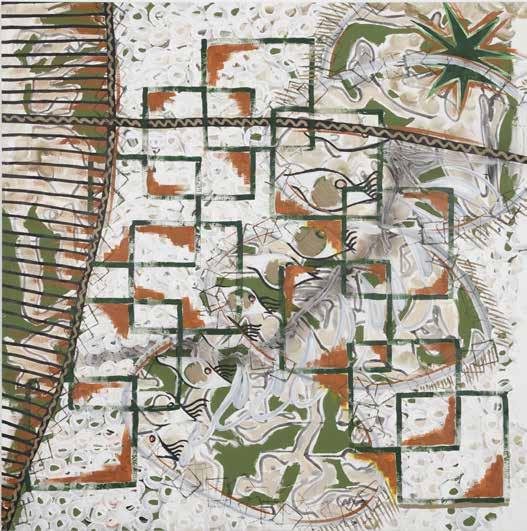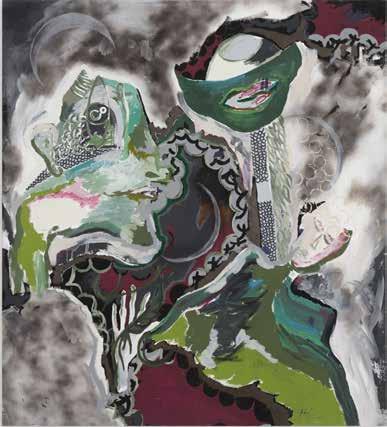
2 minute read
Andy Villela
Ortigueira é um dos trabalhos que compõem minha mais recente pesquisa sobre perspectivas poéticas dos territórios brasileiros. Ao me debruçar sobre os textos de Milton Santos, compreendi outras perspectivas sobre territorialidade e do próprio espaço geográfico e arquitetônico das cidades. Partindo da premissa que o território se estabelece em duas ou mais formas, socialmente e materialmente, observar tais espaços que nos constituem se dá como uma prática importante para nossa construção, tanto no âmbito pessoal quanto artístico. A teoria da tecnoesfera e da psicoesfera de Milton me auxiliou na produção pictórica da pintura, aplicando a interação de ambos os conceitos e provocando, promovendo e instituindo signos para atender às dinâmicas no caráter processual das obras.
Ortigueira is one of the works that make up my most recent research on poetic perspectives of Brazilian territories. As I studied Milton Santos’ texts, I understood other perspectives on territoriality and the geographic and architectural space of cities. Starting from the premise that the territory is established in two or more ways - socially and materially - observing such spaces that constitute us is an important practice for our construction, both in the personal and artistic scope. Milton’s theory of the technosphere and psychosphere helped me in the pictorial production of painting, applying the interaction of both concepts and provoking, promoting and instituting signs to meet the dynamics in the procedural nature of the works.
Advertisement
Ádito é acesso, entrada, caminho por onde se chega a algum lugar. Com uma camada surrealista, Ádito compõe um cenário em um tempo-espaço múltiplo, reproduzindo essa dinâmica no processo da feitura das pinturas, através da investigação, da liberação do fluxo de ideias do subconsciente que revelam diferentes texturas, formas, cores e signos.
Ádito is access, entrance, path through which one arrives somewhere. With a surrealist layer, Ádito composes a scenario in a multiple time-space, reproducing this dynamic in the process of making paintings through investigation, the release of the flow of ideas from the subconscious that reveals different textures, shapes, colors and signs.
Andy Villela, 1994, nasceu e reside no Rio de Janeiro. A artista utiliza a pintura como eixo dorsal de sua produção. Comunica-se através de símbolos do inconsciente, cedendo espaço para estímulos distintos onde cores, formas e caminhos dão significados às obras através do próprio processo de elaboração. Seu trabalho parte do contato com os materiais e como se desenvolvem em uma linguagem investigativa geralmente atreladas à experimentações pictóricas, propondo questionamentos acerca da racionalidade social e estética pressupostas por normas vigentes. Num resgate emancipatório de criação de uma linguagem própria, sua pintura mescla figurativo e abstrato, afastando a possibilidade de uma leitura literal, tensionado à escala humana e tangível a outras espacialidades, construindo assim, uma narrativa não-linear e que não se atém apenas a pura aleatoriedade, mas permite ir além da imposição de um fazer anestesiado.
Andy Villela (1994) lives in Rio de Janeiro. The artist uses painting as the backbone of her production. She communicates through symbols of the unconscious, giving way to different stimuli with colours, shapes and paths that give meaning to the works through the developmental process itself. Her work starts from the contact with materials and the way they develop into an investigative language generally linked to pictorial experimentation, questioning the social and aesthetic rationality presupposed by current norms. In an emancipatory recovery of the creation of a language of its own, her painting mixes the figurative and the abstract, dismissing the possibility of a literal reading, tensioned to the human scale and tangible to other spatialities, thus building a non-linear narrative that does not simply stick to pure randomness, but allows for a going beyond the imposition of an anesthetized making process.











